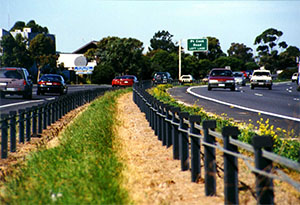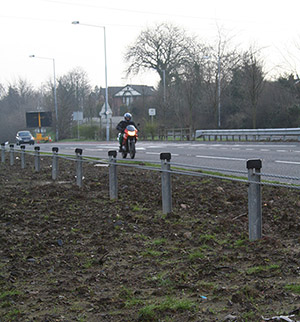 Australia – Wire Rope Barrier (WRB) illustrates much of what is wrong with our roadsides.
Australia – Wire Rope Barrier (WRB) illustrates much of what is wrong with our roadsides.
Roadside hazards are involved in ~40% of all accidents (with all vehicles).
Up to 30% of all motorcycle, fatalities involve a post, pole or tree.
Around 2.4-2.6% of Australian motorcycle, fatalities involve a barrier (up to 16% overseas). This figure increases further for casualties.
In such accidents, the exposed posts constitute most of the hazard.
Exposed posts concentrate impact forces and lead to increased soft tissue injuries, fractures, amputations and deaths. ALL barriers stop most cross over accidents!!! …but WRB has the greatest number of exposed posts of any barrier.
Ergo WRB has the greatest potential to kill riders
Posts
There are many examples of reduced surface area and sharp edges causing injuries and fatalities. Telephone poles, signs and trees all figure prominently in injuries and fatalities. In German research on the consequences of impacts with posts, cadavers were propelled into metal posts. Amputations and fractures resulted.
Researchers provided measurements of the impact forces generated (making comparison easier). An impact with a series of WRB posts would generate similar forces and similar injuries. It would be more than sufficient to kill someone. Even a slow impact with a post is enough to kill a rider!
MUARC (Monash University Accident Research Centre) testing has compared WRB to obsolete Jersey concrete barrier. Vic Roads says it has not used Jersey for over 20 years because it rolls cars NB. Injuries are much more serious when a car rolls. WRB rolled cars during testing too!
This original report has never been released to the public only MUARC researchers have access to it (is something being hidden?). F-profile concrete barrier is currently in use and has about half the rollover rate of the Jersey profile. Does this make F-profile safer than WRB? Newer concrete barrier types (Texas profile) have an even lower rollover rate than F-profile. Why weren’t they tested?
These same reports also failed to identify that overseas the rate of barrier fatalities for motorcyclists is much higher (up to 16%). This demonstrates that as exposure increases fatality rates will too ie. More unsafe barriers means more deaths!
Cross-Overs

Cross-over accidents (into on-coming traffic) are of greatest concern. Almost any barrier in the median would prevent most crossover accidents. WRB claims to stop 100% of cross-overs.
This is untrue.
Hitting WRB posts often catapults a rider over the barrier into on-coming traffic NB. 37% of riders go over the top of barriers!
This catapult action does not happen with a smooth faced barrier. Larger vehicles are also not stopped by WRB. By comparison the simple concrete barrier stops even large trucks. In 2006 24th July in Yatala Queensland a truck went through WRB on a freeway killing one and injuring 8.
Comparable Hazards
Impacts with trees and other objects are common roadside accident scenarios. Motorcyclists have been requesting the removal of trees and other objects from medians for years (RIP Helen Hawthorn)! This simple and cheap intervention would save many lives. Barriers with exposed posts contribute to the problem.
Rollovers
Roadside accidents commonly include rollovers. Rollovers significantly increase the risk of injury or death. Installing WRB required a fair bit of landscaping so that cars did not roll before they hit the barriers! The landscaping alone may have been sufficient in many cases NB. 85% of all vehicles travelling at 100Km/hr recover in a 9m clear zone (no barriers required).
Costs
Typical installation and repair costs for simple installations:
Installation Cost/metre Typical Repair Costs/metre
Concrete $150+ Negligible (80yr+ lifespan)
Steel W-beam $120+ $80 to $150
Wire ropes $130+ $25
These are Vic Roads figures NB. Independent contractors quoted an even lower $150/m for a complex concrete barrier installation with footings and drainage. Less if you wanted lots of it.

Thus, installation costs for all barrier types are similar. However after only one impact, maintenance costs make WRB more expensive than concrete.
Over the years, WRB will be many times more expensive than alternatives because it requires more maintenance: Placing it closer to the road results in it being damaged more frequently.
Also larger sections are damaged when hit. These costs are at odds with claims that WRB is cheap.
Accident facts
- Motorcyclists tend to hit barriers like concrete at shallow angles because they leave the road at shallow angles.
- Concrete has no projections so motorcyclists slide along the barrier.
- 85% of vehicles recover within 9m of a 100km zone (no barriers required).
- 37% of riders go over the top of barriers: Items behind barriers kill riders!
- Exposed posts kill riders!
WRB:
-
Is easily damaged
- Is less effective/ineffective until repaired
- Is often extensively damaged (large sections unserviceable)
- Can create a hazard until repaired
- Can spend long periods of time between repairs (7-30+ days)
- Has very high maintenance costs (whole of life cost effectiveness is very poor)
- Can fling a rider over the barrier… and into oncoming traffic or some other hazard
- Is safer for motorcyclists the further it is placed from the road
- Becomes more expensive to maintain the closer you place it to the road
- Sometimes needs to be duplicated on both sides of a median (doubling the cost)
- Acts like a solid barrier to riders (because riders are much lighter than cars)
- Stops riders suddenly when they hit the posts (rapid deceleration)
- The exposed posts are the major hazard to riders
- The cabling has never been tested with riders
- Is NOT designed to stop trucks or large vehicles
Concrete barriers:
- Have little or no maintenance costs
- Are functional effectively 100% of the time
- Have similar installation costs to WRB
- Are the most forgiving barrier for motorcyclists (of the 3 listed)
- Reduce light glare at night
- Prevent more cross-over accidents than WRB
- Are safer at shallow impact angles (<30 degrees)
- Stop trucks
Alternative Solutions
Cover the posts and barriers become much safer:
- Expanded foam impact attenuators placed around posts reduce impact forces by 50%
- Mototub is a compressible rubber tube placed along the bottom of WRB, Armco and other barriers to prevent riders from sliding into posts.
- Armco is a safe alternative if the posts are covered (top & bottom) e.g. In countries like Portugal they use tyres to protect the posts.
Use barriers without exposed posts or other projections:
- Concrete has a smooth snag free surface
- Tire barriers on racetracks are very successful at preventing injury.
Decelerate vehicles gradually:
- Gravel, sand and other materials (such as shredded rubber) on racetracks/roads stop motorcycles, cars and trucks safely at very high speeds.
- Water filled collapsible barriers are extremely effective at dissipating extreme impact forces with minimal injury even for large vehicles.
Remove Hazards
This alternative needs to be applied more frequently. Usually it is the cheapest of all the options. Once implemented it fixes the problem for good, usually makes barriers unnecessary and requires little or no ongoing expenditure.
Why is safe design a smart move?
- At least 30% of all road fatalities could be avoided by better design
- Motorcyclists are amongst those most prone to injury and death due to bad design
- Good design is much cheaper than bad design
- Good design for motorcyclists is generally good for other road users
- Vic Roads is under funded by around $1Billion/yr. It can not afford expensive solutions if cheap ones exist.
If you’d like more information on this or other road safety issues you can check out the Motorcycle Research file area at Motorcycle Research Yahoo Group the MRAA website at www.mraa.org.au
Michael Czajka
Michael is the MRAA’s Road Safety & Research Officer. He sat on the Victorian (Transport Ministers) Motorcycle Advisory Committee (VMAC) for many years Vic Roads Motorcyclists
He has been the MRAA rep to the ATSB’s (Australian Transport Safety Bureau) motorcycle safety advisory council www.atsb.gov.au for 10 years.
He has been a member of the AMC (Australian Motorcycle Council), which is the peak rider group for Australia www.amc.asn.au


We are very happy with the decision of our transport minister in 2005 to ban cable barriers in the Netherlands.
We did not need a lot of research to explain why these “killer cables” never should be used in our infrastructure.
Fortunately our government showed common sense and the cable barrier in the Netherlands became part of history.
It still is at least remarkable that authorities in other countries simply deny the potential dangers of this type of barrier, in particular for motorcyclists.
Nico Perk
Chairman of the Dutch riders organisation MAG
(Motorrijders Actie Groep)
We are also member of FEMA
(Federation of European Motorcyclists’ Associations)